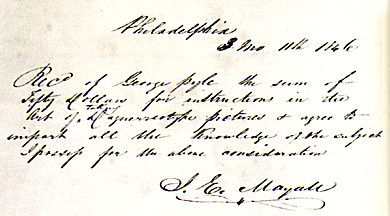|
 Old records were written by hand. Often this
"handwriting" or "penmanship," as it was called not too long ago, is
indecipherable. Handwriting, as with language, changes over time, so what may have been
common practice years ago is no longer used. Not only have our words and their meanings
changed throughout the years, the way we form the letters has, too. Old records were written by hand. Often this
"handwriting" or "penmanship," as it was called not too long ago, is
indecipherable. Handwriting, as with language, changes over time, so what may have been
common practice years ago is no longer used. Not only have our words and their meanings
changed throughout the years, the way we form the letters has, too.
Old-time script can make a genealogist's head spin. However, chances are that an old
document may contain valuable information, so it's worth taking extra time to read it
carefully. In order to get the most information from the records that are available, a
genealogist has to decipher them and put meaning into the symbols on the old documents. As
a genealogist searches old Bible, census, courthouse, archive and Church records to obtain
names, places and dates, often the words are unclear. Also, the older the document, the
harder it is to read. So where should a researcher begin?
Use the known to take you to the unknown. Study the way in which letters were made,
especially in obvious words. Legal documents are loaded with terms like
"whereas," "wherefore,' and "hence." An ancestor s name is
another good place to begin. Make a note of the letters in those words, and try to find
them in others. An important note to remember is that much of the writing is
"phonetic." Clerks often wrote a name the best that they could by how it
sounded.
In early American documents--those written in the late 18th and early 19th
centuries--be on the lookout for what's known as the long or leading "s."
This letter looks a lot like today's lower-case f, but it was often used in
colonial times as the first s when two appeared together, such as in Congrefs,
progrefs, blefsing. A name like Jesse would have been written Jefse. Good
examples of this can be found in a handwritten copy of the Declaration of Independence.
Also, watch for common abbreviations. Early record keepers, to save paper and time,
shortened many words. Since only those working in a certain office would actually read the
records, abbreviations varied from office to office and place to place. Some examples
include iF for "Junior," S for "said," and afsd
for "the aforesaid," which means the person previously mentioned. They tended to
abbreviate names as well--Abra- stood for Abraham, W" or Will
for William, Margt for Margaret, Jo/n for John, and Geo: for
George.
Lines were often used in abbreviations. They can be found over, under and through any
given abbreviation. Single and double dots in a variety of positions were used as well.
Smaller letters, both above and below the main letter, are common.
Capital letters can be especially hard to figure out. L and T often
look the same; M and N, I and i, L and 5, and U
and V all can be difficult to differentiate. The best way to tackle any old
document is to become familiar with the writer's style. Look through the document for
obvious words, noting how the writer made capitals and small letters. Through the process
of elimination, many letters can be figured out. For a particularly difficult letter, make
a list of all the letters it could possibly be, and then search for them in the document.
Numbers were also written differently. Often, a "7" will be written
in the European style with a slash through its stem. The numbers "8"
and "6" can also be hard to differentiate in old records. A "6"
looked more like a lower-case "b," while an "8"
resembled a lower-case "d" with a hook at the top.
In English-language documents, read through a sentence and make guesses at what a
difficult word could be. Often, the context of a sentence will help in deciphering a
missing word.
Libraries, especially larger ones, often have handwriting-style cards for the period
being researched. These tend to show a variety of styles for every letter.
|
